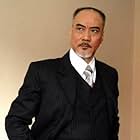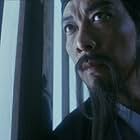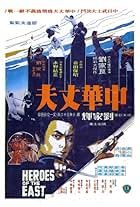VALUTAZIONE IMDb
7,2/10
2447
LA TUA VALUTAZIONE
Aggiungi una trama nella tua linguaThe best sword master from China vs the best sword master from Japan. Who will win?The best sword master from China vs the best sword master from Japan. Who will win?The best sword master from China vs the best sword master from Japan. Who will win?
- Premi
- 2 candidature
Flora Chong-Leen
- Sheng Nan
- (as Flora Cheung)
Yeong-moon Kwon
- Shaolin Abbot
- (as Yeong-Mun Kwon)
Trama
Lo sapevi?
- QuizThe English subtitles on the 2021 Blu-ray release by Eureka uses names for the Japanese characters that are different from those on previous releases of the film. Norman Chu's character, previously known as "Hashimoto", is here referred to as "Miyamoto Ichiro"; and the character played by Eddy Ko, previously known as "Kenji", is here called "Kaneda". According to the audio commentary by Frank Djeng, the translated names used on previous editions were incorrect, and the new edition's replacement names are more accurate.
- BlooperWires are noticeably visible in some shots during the final battle.
- Citazioni
Ching Wan: Don't you sometimes feel sad for us martial artists? If we're incompetent, then we can easily get killed. But if we're good, then either we challenge other masters or we ourselves keep getting challenged and can never have peace.
Hashimoto: Do you regret it?
Ching Wan: I don't regret the life I've chosen. Do you?
Hashimoto: Neither do I.
- Versioni alternativeUK VHS versions of this film were cut by 5 seconds to remove all shots of shuriken (ninja throwing stars), as these were on the no-no weapons list of the British Board of Film Classification (BBFC) at the time. When resubmitted to the BBFC in 2004 under revised guidelines in which shuriken were no longer a problem, the film was passed uncut for the UK DVD release.
- ConnessioniFeatured in The Best of the Martial Arts Films (1990)
Recensione in evidenza
Beautiful, confusing, chaotic. Motivations hard for us westerners to understand. (The great combat is fought not for riches or territory, but only for honor.) Gleefully bends the laws of physics, and plays with your reason in the finest HK (Hong Kong) tradition.
I have shared this film with folks who had not previously experienced HK film, and they were instantly captivated. Or should I say captured. By the Ninjas.
Because -- this film's certainly got the Ninjas! Surf Ninjas! Sand Ninjas! Exploding Ninjas! Tree Ninjas! Flying Ninjas! Roof Ninjas! Giant Ninjas! Kite Ninjas! Naked Girl Ninjas! (Oh, that long-haired Naked Fu...)
Just as with life, every time things quiet down in this film, you may be sure the Ninjas will pop up to keep things lively.
Watch this and be captured. You have been warned.
I have shared this film with folks who had not previously experienced HK film, and they were instantly captivated. Or should I say captured. By the Ninjas.
Because -- this film's certainly got the Ninjas! Surf Ninjas! Sand Ninjas! Exploding Ninjas! Tree Ninjas! Flying Ninjas! Roof Ninjas! Giant Ninjas! Kite Ninjas! Naked Girl Ninjas! (Oh, that long-haired Naked Fu...)
Just as with life, every time things quiet down in this film, you may be sure the Ninjas will pop up to keep things lively.
Watch this and be captured. You have been warned.
- insightstraight
- 29 gen 2004
- Permalink
I più visti
Accedi per valutare e creare un elenco di titoli salvati per ottenere consigli personalizzati
- How long is Duel to the Death?Powered by Alexa
Dettagli
Contribuisci a questa pagina
Suggerisci una modifica o aggiungi i contenuti mancanti

Divario superiore
By what name was Xian si jue (1983) officially released in India in English?
Rispondi





























